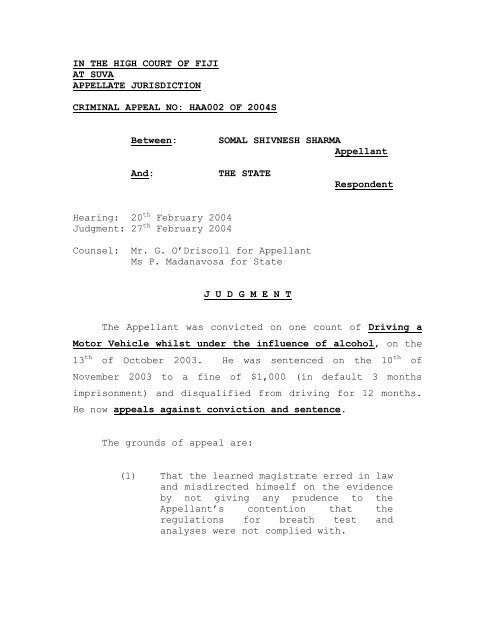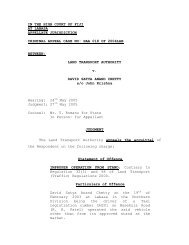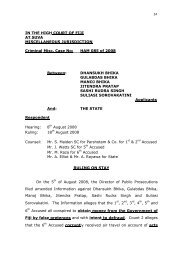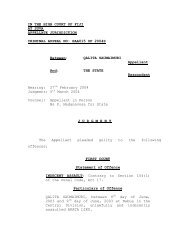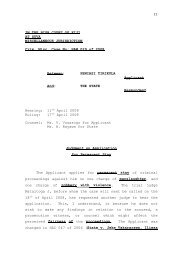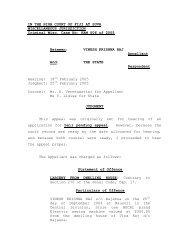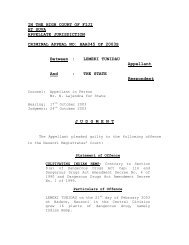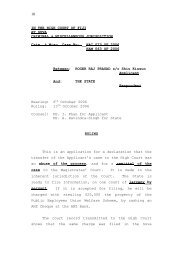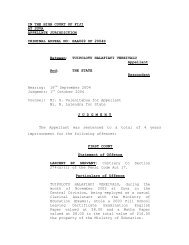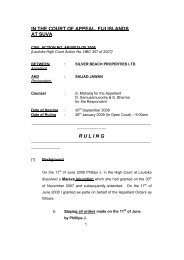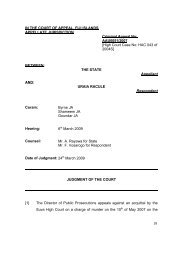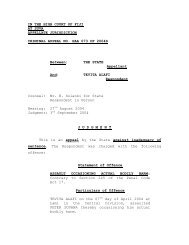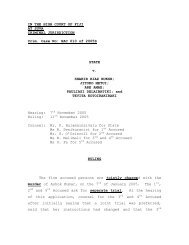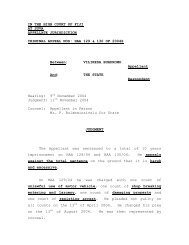Download Somal Shivnesh Sharma v State Judgement - Law Fiji
Download Somal Shivnesh Sharma v State Judgement - Law Fiji
Download Somal Shivnesh Sharma v State Judgement - Law Fiji
Create successful ePaper yourself
Turn your PDF publications into a flip-book with our unique Google optimized e-Paper software.
IN THE HIGH COURT OF FIJI<br />
AT SUVA<br />
APPELLATE JURISDICTION<br />
CRIMINAL APPEAL NO: HAA002 OF 2004S<br />
Between:<br />
SOMAL SHIVNESH SHARMA<br />
Appellant<br />
And:<br />
THE STATE<br />
Respondent<br />
Hearing: 20 th February 2004<br />
Judgment: 27 th February 2004<br />
Counsel: Mr. G. O’Driscoll for Appellant<br />
Ms P. Madanavosa for <strong>State</strong><br />
J U D G M E N T<br />
The Appellant was convicted on one count of Driving a<br />
Motor Vehicle whilst under the influence of alcohol, on the<br />
13 th of October 2003. He was sentenced on the 10 th of<br />
November 2003 to a fine of $1,000 (in default 3 months<br />
imprisonment) and disqualified from driving for 12 months.<br />
He now appeals against conviction and sentence.<br />
The grounds of appeal are:<br />
(1) That the learned magistrate erred in law<br />
and misdirected himself on the evidence<br />
by not giving any prudence to the<br />
Appellant’s contention that the<br />
regulations for breath test and<br />
analyses were not complied with.
2<br />
(2) That the learned magistrate erred in law<br />
by not allowing the Appellant’s Counsel<br />
to mitigate on his behalf and proceeded<br />
to enter a sentence that was harsh and<br />
excessive as a result.<br />
The Appellant was originally charged on two counts.<br />
They read as follows:<br />
FIRST COUNT<br />
<strong>State</strong>ment of Offence<br />
DRIVING MOTOR VEHICLE WHILST UNDER THE<br />
INFLUENCE OF DRINKS OR DRUGS: Contrary to<br />
section 102 and 114 of Land Transport Act<br />
1998.<br />
Particulars of Offence<br />
SOMAL SHIVNESH SHARMA s/o Akilesh <strong>Sharma</strong> on<br />
the 31 st day of August, 2001 at Nausori in the<br />
Central Division drove a motor vehicle on<br />
Dilkusha road under the influence of drinks or<br />
drugs to such an extent as to have proper<br />
control of the said motor vehicle.<br />
SECOND COUNT<br />
<strong>State</strong>ment of Offence<br />
DANGEROUS DRIVING: Contrary to section 98(1)<br />
and 114 of Land Transport Act 1998.<br />
Particulars of Offence<br />
SOMAL SHIVNESH SHARMA s/o Akilesh <strong>Sharma</strong> on<br />
the 31 st day of August, 2001 at Nausori in the<br />
Central Division drove a motor vehicle on<br />
Dilkusha Road in a manner which was dangerous<br />
to the public having regards to the<br />
circumstances of the case.
3<br />
On the 16 th of October 2002, the Appellant pleaded<br />
guilty on Count 1 and not guilty on Count 2. On the 9 th of<br />
January 2003, he was represented by counsel, pleas were retaken<br />
and he pleaded not guilty on both counts. The trial<br />
commenced on the 11 th of September 2003.<br />
PC Esili Nadolo, gave evidence that on the 31 st of<br />
August 2001 at 11.45pm he attended a report of an accident<br />
at Dilkusha Road, Nausori. He found a white vehicle<br />
registration number CP929 inside a drain. He called for<br />
the driver. The accused came forward and identified<br />
himself. PC Nadolo could smell alcohol on his breath. He<br />
gave the accused three options, to be examined by a police<br />
officer, a government doctor or a private doctor at his own<br />
expense. He chose to be tested by a Government doctor.<br />
The officer then drew a rough sketch plan which he<br />
tendered. He took the Appellant to the hospital where a<br />
doctor examined him and took urine, and blood samples. The<br />
Government Analyst found the Appellant’s blood alcohol<br />
level to be 131.7mg and urine alcohol level to be 115.4mg.<br />
The doctor concluded that the Appellant was under the<br />
influence of alcohol to the extent that he was incapable of<br />
having proper control of his vehicle.<br />
Under cross-examination, the witness agreed that<br />
although he arrived at the scene at 12 midnight, he did not<br />
take the Appellant to the hospital until 1.45am. The<br />
reason for the delay was that there was risk that people<br />
would steal from the vehicle. The witness agreed that the<br />
vehicle had not been inspected by the Land Transport
4<br />
Authority, and that the Appellant had not been subjected to<br />
a breathalyser test.<br />
PW2, DPC Vilikesa interviewed the Appellant under<br />
caution and also charged him. In his interview, the<br />
Appellant said that his friend had been driving the car<br />
that night and that the car broke down on the Dilkusha<br />
Road. The Appellant then sat in the driver’s seat to allow<br />
it to be “push-started.” The interview then reads:<br />
“The car start then we came down the slope and<br />
I suppose to stop the car to change driver<br />
then I went on and some people was coming on<br />
the road and they want to cross and I tried to<br />
evade them but the car went over a pipe and<br />
tyre blew and I drove the vehicle to the<br />
drain.”<br />
night.<br />
He admitted that he had drunk a “couple” of beers that<br />
At the end of the prosecution case, counsel for the<br />
Appellant made a submission that there was no evidence of<br />
dangerous driving on Count 2. The Court agreed. The<br />
learned Magistrate found that the accused had not driven<br />
“in such a way that may cause havoc on the road or to other<br />
road users.” He also found that it was wrong to try a<br />
person for both dangerous driving and drink driving on the<br />
same facts and acquitted him on Count 2. He found a case<br />
to answer on Count 1.
5<br />
The Appellant decided to give sworn evidence. He said<br />
that his car had got stuck at Dilkusha and it was pushstarted<br />
as a result of which it rolled down the hill. The<br />
tyre was struck by a galvanised pipe, it blew and the car<br />
landed in the drain. He could not steer it in time. Under<br />
cross-examination he said that he was driving the car when<br />
it fell into the drain. He agreed that he had drunk “a<br />
glass or two of alcohol, mixed with juice.”<br />
Counsel for the Appellant submitted that there was no<br />
evidence that the Appellant was so drunk that he was<br />
incapable of driving, that the Appellant was charged<br />
wrongly under section 102 of the Land Transport Act and<br />
should have been charged under section 103 and that the<br />
result of the blood test was unacceptable because the<br />
Appellant had been detained for breath test for more than<br />
30 minutes contrary to section 104(1)(c) of the Land<br />
Transport Act.<br />
Judgment was delivered on 13 th October 2003. The<br />
learned Magistrate accepted the opinion of the doctor who<br />
examined the Appellant and who concluded, on the basis of<br />
the Analyst’s report, that he was incapable of having<br />
proper control of a motor vehicle. He found that the<br />
Appellant had been in the driver’s seat at the time of the<br />
accident, and therefore had control of the vehicle for the<br />
purpose of the meaning of the word “driving.” He found<br />
that section 102 of the Land Transport Act replaced a<br />
similar provision in the old Traffic Act which required<br />
proof of drinking and of incapability. He held that the
6<br />
Appellant had been correctly charged and that his blood<br />
alcohol level was well above the prescribed limit. He said<br />
that there was increased public awareness that a high blood<br />
alcohol level will result in substantial impairment of a<br />
person’s ability to drive properly. He convicted the<br />
Appellant and on the 10 th of November 2003, sentenced him to<br />
$1000 and disqualified him from driving for 12 months. On<br />
that day, the Appellant’s lawyer did not appear. Instead,<br />
Mr. Ram Chand appeared for Mr. O’Driscoll. Inexplicably,<br />
Mr. Chand was not asked to mitigate for the Appellant.<br />
Instead the court asked the Appellant to mitigate himself.<br />
He did so but there is nothing on the record to explain why<br />
the learned Magistrate decided to take this step.<br />
Ground 1<br />
The main submission made by counsel under this ground<br />
is that the blood test taken by the doctor and analysed by<br />
the Government Analyst did not comply with the 30 minute<br />
time limit under section 103 of the Land Transport Act.<br />
Section 102(1) of the Land Transport Act provides:<br />
“(1) A person who drives a motor vehicle or is<br />
in charge of a motor vehicle while under the<br />
influence of intoxicating liquor or any drug<br />
to such an extent as to be incapable of having<br />
proper control of the motor vehicle commits an<br />
offence and is liable on conviction to the<br />
prescribed penalty.”<br />
Section 103(1) provides:
7<br />
“(1) A person who –<br />
(a)<br />
(b)<br />
drives or attempts to drive a motor<br />
vehicle or is in charge of a motor<br />
vehicle while more than the prescribed<br />
concentration of alcohol is present in<br />
his blood; or<br />
fails or refuses to undergo a breath<br />
test or breath analysis when required<br />
to do so by a police officer<br />
commits an offence.”<br />
Section 104 provides that a breath test or analysis<br />
may be conducted on any person in respect of whom section<br />
102(2) applies. That sub-section relates to the police<br />
decision to forbid a person to drive and to order him to<br />
hand his keys over to the officer. Section 104(1)(a)<br />
provides:<br />
“Provided that –<br />
(a) no breath test or analysis shall be<br />
conducted after 2 hours have elapsed from the<br />
time the driver has been driving or in charge<br />
of the motor vehicle unless the breath test or<br />
analysis could not have been carried out<br />
earlier due to the condition of the driver;<br />
(b) a person shall not be detained for the<br />
purposes of breath test or analysis for more<br />
than 30minutes."<br />
There are several reasons why section 103(a) did not<br />
apply to the Appellant in this case. Firstly, he was never<br />
subjected to a breath test or breath analysis. He was<br />
examined by a medical practitioner and he consented to a
8<br />
blood test. The two hour time limit given is in relation<br />
to a breath test, not a blood test. The 30 minute time<br />
limit refers to detention for the purpose of a breath test.<br />
The Appellant was not detained for the purpose of a breath<br />
test. He was detained for medical examination, in the<br />
course of which he agreed to a blood test.<br />
Secondly, the Appellant is charged under section<br />
102(1) of the Act. In order to prove that the Appellant<br />
was too drunk to drive, the police were not required to do<br />
a breath test, or even a blood test, at all. The court can<br />
conclude in any case under section 102(1) that all<br />
ingredients of the offence are proved from the Appellant’s<br />
behaviour after the accident and from his manner of<br />
driving. There is no detention time limit (other than that<br />
under the Constitution) for an offence under section 102(1)<br />
of the Act.<br />
In the course of his submissions, counsel for the<br />
Appellant submitted that the result of the blood test was<br />
unreliable. The evidence was that the blood test was taken<br />
before the doctor concluded that the Appellant was too<br />
drunk to drive. It is not clear why the defence did not<br />
request to cross-examine the doctor, and why it consented<br />
to the medical report being tendered, if it disputed the<br />
conclusion reached by the doctor. However, it was a<br />
conclusion the trial Magistrate was entitled to reach.<br />
Further the doctor was entitled to reserve his opinion<br />
until he received the result of the blood analysis.
9<br />
In Shiu Charan v. Reginam (1972) 18 FLR 114, Grant J<br />
considered the old offence of drunk driving (which has the<br />
same elements as the section 102 offence) and held that<br />
where the prosecution had led evidence of a lay witness who<br />
said that the appellant was drunk, and of a doctor who<br />
found the appellant too drunk to drive, the conviction was<br />
safe. Archbold (2003) Para 32.71 states:<br />
“The prosecution must prove not only the<br />
influence of drink or drugs but also that<br />
proper control of the vehicle is impaired by<br />
drink or drugs (R v. Harkes 22 Cr. App. R. 172<br />
(CA).) This may be shown by evidence of: (a)<br />
the manner of driving; (b) the driver’s<br />
physical condition; (c) the proportion of<br />
alcohol in a specimen of breath, blood or<br />
urine pursuant to section 15 of the RTOA<br />
1988.”<br />
Section 102 does not contain the equivalent of section<br />
15 of the English legislation. However the principles<br />
outlined by Archbold apply here, except that in the case of<br />
(c), a court in <strong>Fiji</strong> should not assume that a<br />
blood/breath/urine test proves incapability without the<br />
taking and accepting of expert evidence in this regard. In<br />
this regard that the learned Magistrate appears to have<br />
concluded that the Appellant was too drunk to drive on the<br />
basis of public knowledge he was in error. However, the<br />
doctor’s expert opinion was before the court, and that was<br />
sufficient to convict.<br />
In DPP v. Ben Tausia Crim. App. No. 5 of 1984 the <strong>Fiji</strong><br />
Court of Appeal considered the kind of evidence capable of
10<br />
sustaining a conviction for the old offence of Drunk<br />
Driving. It adopted the following passage from a decision<br />
of Grant C.J. in R v. Chaudhary Cr. App. 95 of 1978:<br />
“… the prosecution have to prove firstly, that<br />
the driver was under the influence of drink,<br />
on which the evidence of lay witnesses may be<br />
received; and secondly that he was under the<br />
influence of drink to such an extent as to be<br />
incapable of properly controlling the motor<br />
vehicle which may be established in a variety<br />
of ways, such as the manner of driving, or the<br />
circumstances of an accident, or the evidence<br />
of a duly qualified medical practitioner who<br />
has examined the driver and who, as an expert<br />
witness, is in a position to express an<br />
opinion that he was under the influence of<br />
drunk to such an extent as to be incapable of<br />
having proper control.”<br />
In Ben Tausia the appellate judge had allowed an<br />
appeal against conviction on the basis that there had been<br />
no expert evidence and no accident. But the Court of<br />
Appeal, in restoring the conviction said, at page 5:<br />
“We accept the appellant’s submission that<br />
neither Davies nor Chaudhary attempts to chose<br />
the categories of evidence required to<br />
establish inability to drive. Neither case<br />
supports the proposition in law, put forward<br />
on behalf of the respondent, that a person<br />
facing this charge is entitled to an acquittal<br />
where there has been no accident and no<br />
medical examination.”<br />
And at page 6:
11<br />
“The basic principle however, is that it is<br />
for the Court eventually to decide, with the<br />
assistance of opinion evidence where experts<br />
are available or without it, on other<br />
admissible evidence, where they are not,<br />
whether the accused was unfit to drive. The<br />
evidence of an expert even of a doctor, need<br />
not necessarily be accepted (see Blackie v.<br />
Police (1966) NZLR 409). Nor is there any<br />
rule of law that in the absence of medical<br />
opinion, a reasonable doubt must necessarily<br />
remain in cases where there has been no<br />
accident.”<br />
In this case there was no evidence of manner of<br />
driving. The learned Magistrate appears to have accepted<br />
the Appellant’s defence of mechanical defect and therefore<br />
that there was no fault displayed by him. We are left<br />
therefore with the conclusion of the doctor, based on the<br />
blood analysis. Was the learned Magistrate entitled to<br />
accept this evidence alone, to convict? The authorities I<br />
have cited, say that he was.<br />
The evidence of a doctor, who gives his opinion that a<br />
person is too drunk to drive, is the evidence of a<br />
professional expert whose opinion is rendered to assist the<br />
court (R v. Lanfear (1968) 2 QB 77). A lay witness may<br />
give evidence that the accused was drunk, but he cannot say<br />
that the accused was too drunk to drive. A medical<br />
practitioner can give that opinion, and a court can rely on<br />
that evidence to convict the accused even without any other<br />
evidence. In this case, the doctor’s opinion was tendered<br />
without dispute, the thrust of the defence being that there<br />
was no evidence of manner of driving. The lack of that
12<br />
evidence might have been fatal if the police had not<br />
obtained the doctor’s opinion. Further, the learned<br />
Magistrate also referred to the prescribed limit under<br />
section 103 of the Act to support his finding. As I have<br />
said, this latter finding could not have justified a<br />
conviction on its own. The court also needed to have the<br />
expert opinion of a doctor as to unfitness to drive or some<br />
other evidence to allow the court to infer unfitness from<br />
the manner of driving and the accused’s own conduct (for<br />
instance a staggering gait or a heavy smell of liquor). In<br />
this case there was no evidence of manner of driving but<br />
there was some evidence of the smell of liquor. In the<br />
circumstances the learned Magistrate was entitled to find<br />
the case proven beyond reasonable doubt.<br />
Ground 2<br />
Counsel did not appear on the day of sentence.<br />
Instead he instructed Mr. Ram Chand to appear. However the<br />
court asked the Appellant to mitigate in person. I can<br />
only speculate as to the reason why. Perhaps Mr. Chand was<br />
not asked to mitigate. Perhaps he did not ask for more<br />
time to prepare for mitigation if he was not prepared.<br />
Perhaps the Appellant asked to mitigate in person.<br />
Whatever the reason, the practice of asking the accused to<br />
mitigate when he has counsel appearing for him is very<br />
unusual. It certainly warrants an explanation on the court<br />
record as to the reason why the learned Magistrate saw fit<br />
to break with the established practice of the Bar and<br />
Bench.
13<br />
Despite this unusual occurrence, I note that the<br />
Appellant did mitigate, that Mr. Chand who is a senior<br />
member of the Bar obviously acquiesced in the proceedings,<br />
and that the sentence passed on the Appellant is well<br />
within the tariff for section 102 offences. For these<br />
reasons, the appeal against sentence is dismissed.<br />
Conclusion<br />
This appeal against conviction and sentence is<br />
dismissed.<br />
………………………………………………………<br />
Nazhat Shameem<br />
JUDGE<br />
At Suva<br />
27 th February 2004


